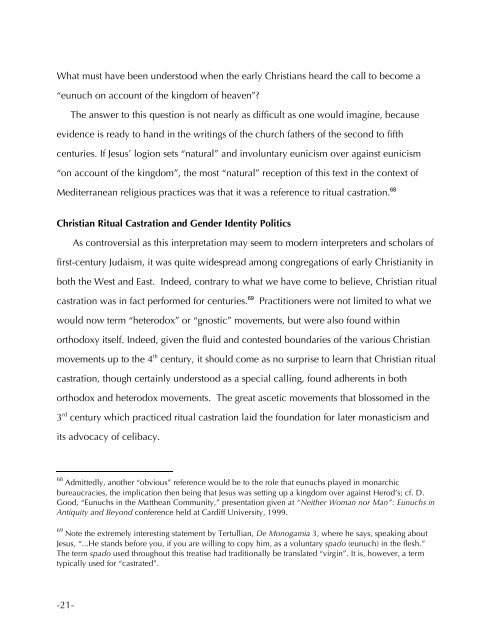-1- Eunuchs and the Postgender Jesus: Matthew 19:12 and ...
-1- Eunuchs and the Postgender Jesus: Matthew 19:12 and ...
-1- Eunuchs and the Postgender Jesus: Matthew 19:12 and ...
Create successful ePaper yourself
Turn your PDF publications into a flip-book with our unique Google optimized e-Paper software.
What must have been understood when <strong>the</strong> early Christians heard <strong>the</strong> call to become a<br />
“eunuch on account of <strong>the</strong> kingdom of heaven”?<br />
-21-<br />
The answer to this question is not nearly as difficult as one would imagine, because<br />
evidence is ready to h<strong>and</strong> in <strong>the</strong> writings of <strong>the</strong> church fa<strong>the</strong>rs of <strong>the</strong> second to fifth<br />
centuries. If <strong>Jesus</strong>’ logion sets “natural” <strong>and</strong> involuntary eunicism over against eunicism<br />
“on account of <strong>the</strong> kingdom”, <strong>the</strong> most “natural” reception of this text in <strong>the</strong> context of<br />
Mediterranean religious practices was that it was a reference to ritual castration. 68<br />
Christian Ritual Castration <strong>and</strong> Gender Identity Politics<br />
As controversial as this interpretation may seem to modern interpreters <strong>and</strong> scholars of<br />
first-century Judaism, it was quite widespread among congregations of early Christianity in<br />
both <strong>the</strong> West <strong>and</strong> East. Indeed, contrary to what we have come to believe, Christian ritual<br />
castration was in fact performed for centuries. 69 Practitioners were not limited to what we<br />
would now term “heterodox” or “gnostic” movements, but were also found within<br />
orthodoxy itself. Indeed, given <strong>the</strong> fluid <strong>and</strong> contested boundaries of <strong>the</strong> various Christian<br />
movements up to <strong>the</strong> 4 th century, it should come as no surprise to learn that Christian ritual<br />
castration, though certainly understood as a special calling, found adherents in both<br />
orthodox <strong>and</strong> heterodox movements. The great ascetic movements that blossomed in <strong>the</strong><br />
3 rd century which practiced ritual castration laid <strong>the</strong> foundation for later monasticism <strong>and</strong><br />
its advocacy of celibacy.<br />
68 Admittedly, ano<strong>the</strong>r “obvious” reference would be to <strong>the</strong> role that eunuchs played in monarchic<br />
bureaucracies, <strong>the</strong> implication <strong>the</strong>n being that <strong>Jesus</strong> was setting up a kingdom over against Herod’s; cf. D.<br />
Good, “<strong>Eunuchs</strong> in <strong>the</strong> Mat<strong>the</strong>an Community,” presentation given at “Nei<strong>the</strong>r Woman nor Man”: <strong>Eunuchs</strong> in<br />
Antiquity <strong>and</strong> Beyond conference held at Cardiff University, <strong>19</strong>99.<br />
69 Note <strong>the</strong> extremely interesting statement by Tertullian, De Monogamia 3, where he says, speaking about<br />
<strong>Jesus</strong>, “...He st<strong>and</strong>s before you, if you are willing to copy him, as a voluntary spado (eunuch) in <strong>the</strong> flesh.”<br />
The term spado used throughout this treatise had traditionally be translated “virgin”. It is, however, a term<br />
typically used for “castrated”.


